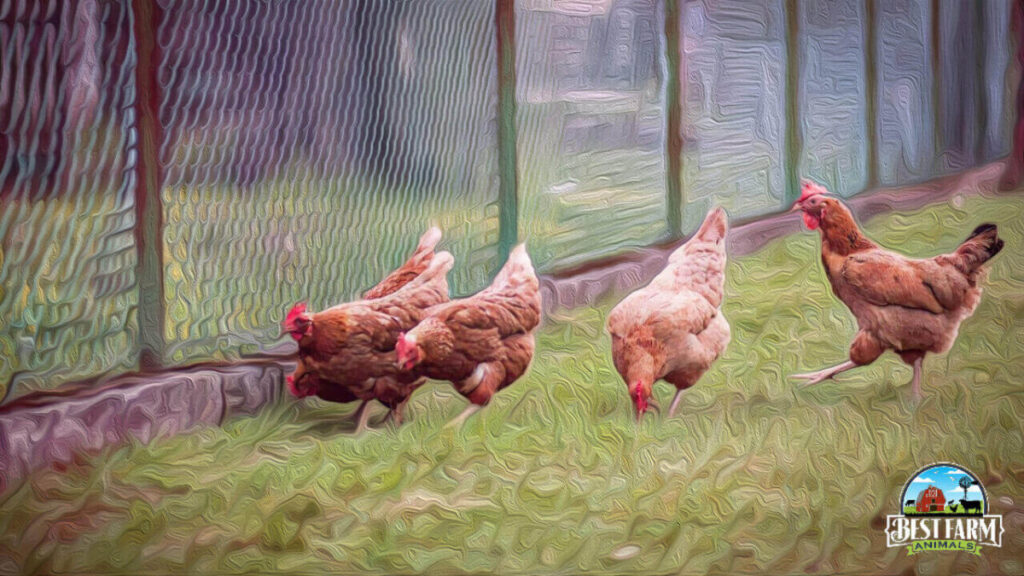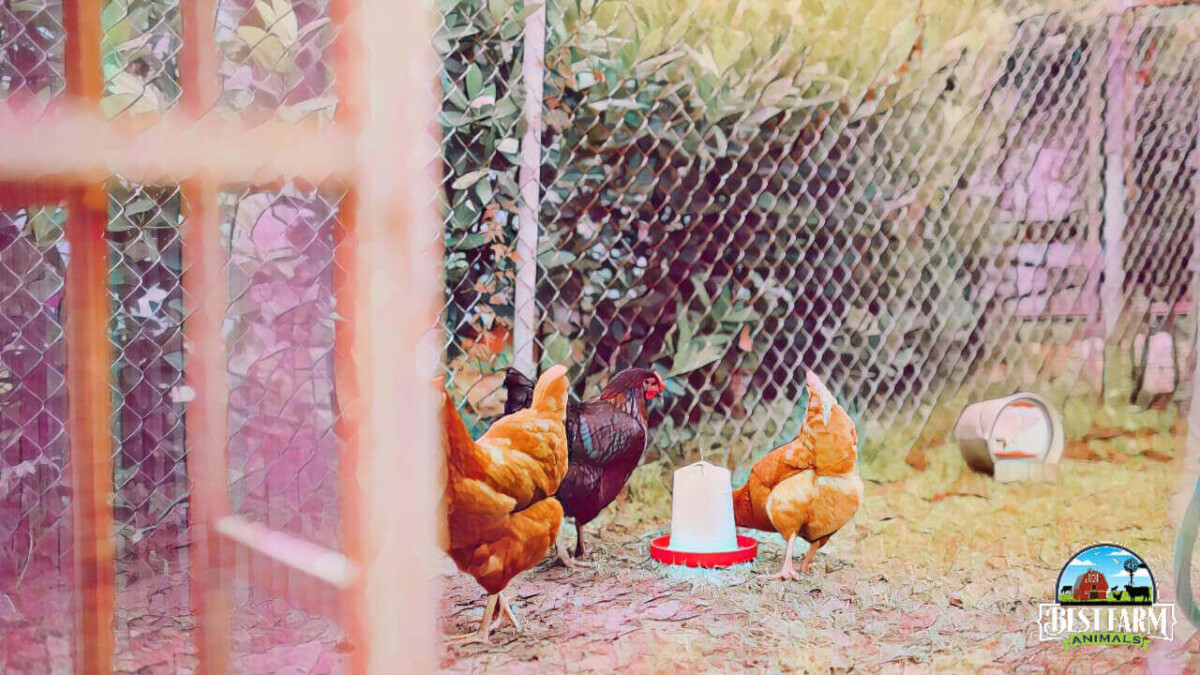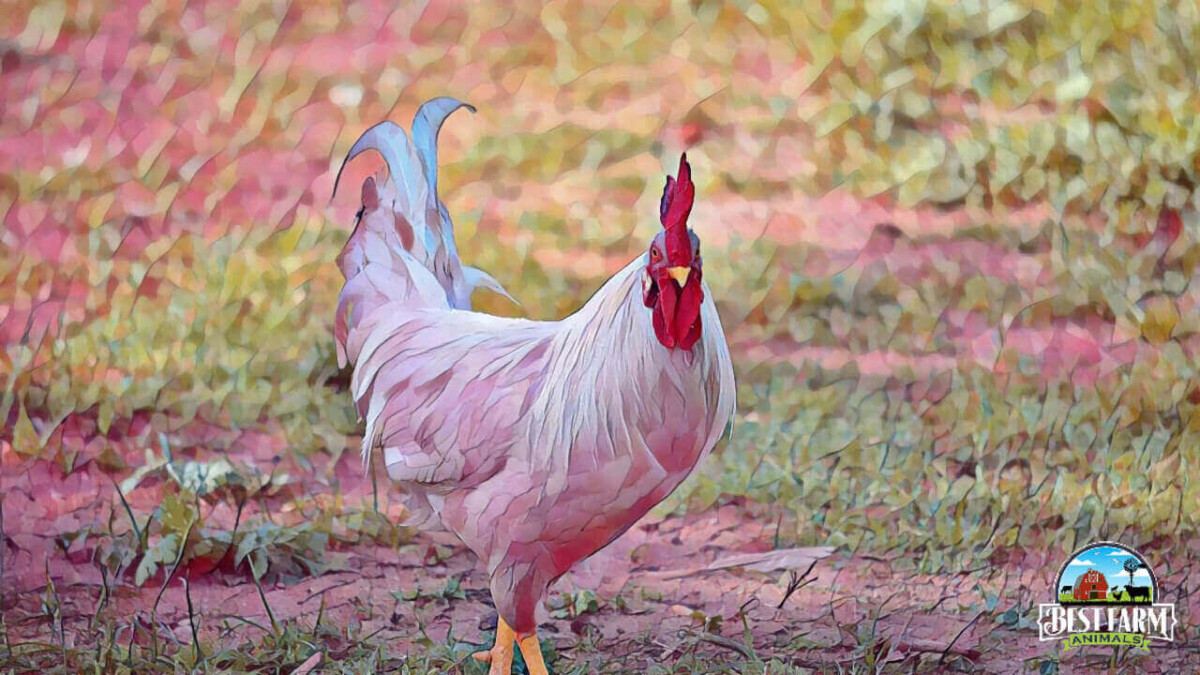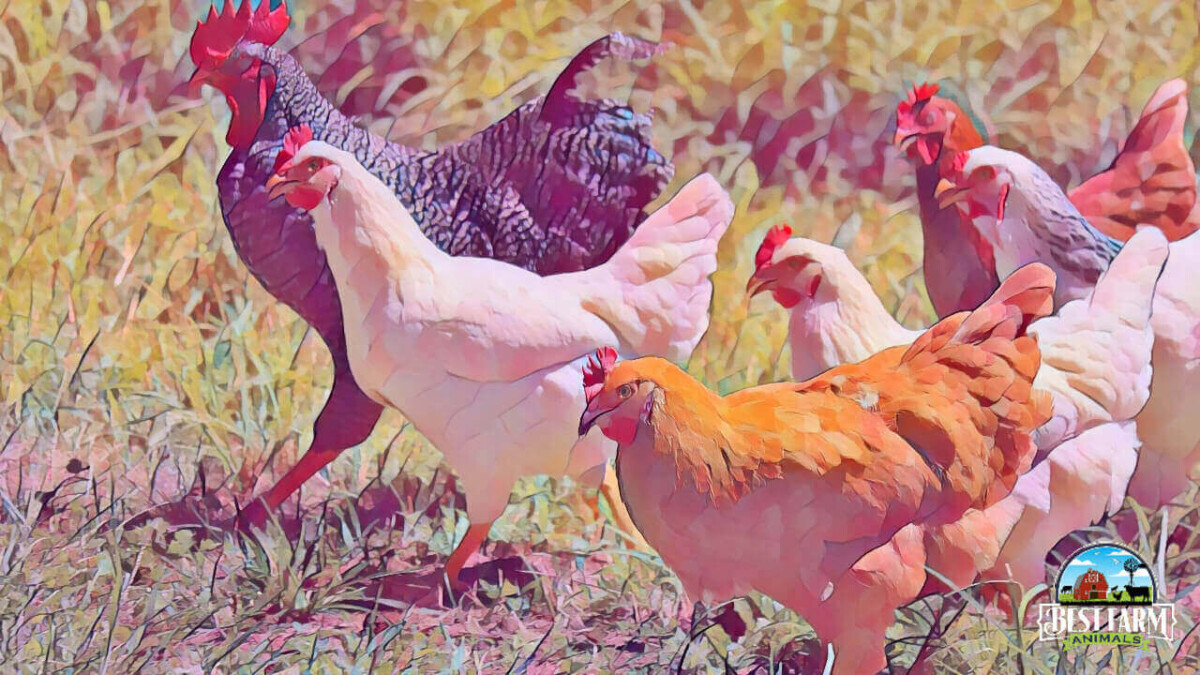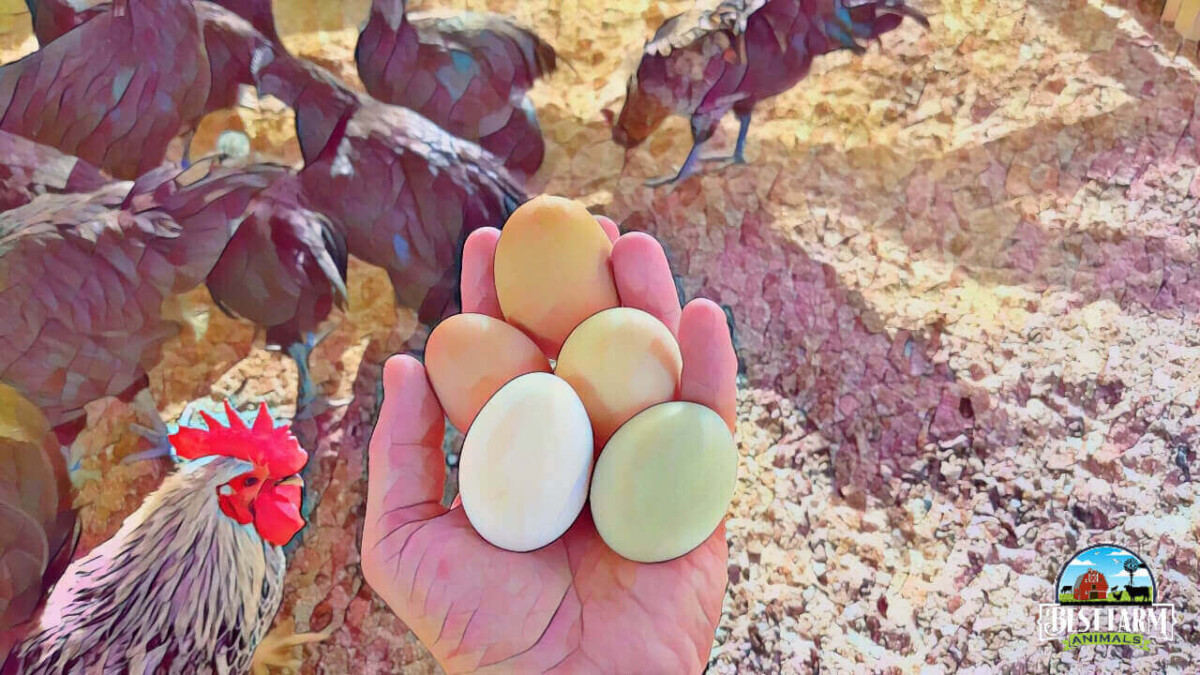We decided to raise chickens on our smallholding as pets for our children. We also have a few horses in our stable. Recently we had a situation where one of the horses stepped on a young chicken named Kippie and broke his leg and wing.
The violent act was traumatic for our family and the chickens, who became skittish around the horses. When our horse stepped on the chicken, there was often quite a lot of blood, but as I got more involved with the upkeep of our chickens, I noticed that they bleed for several reasons.
Concerned about the well-being of our chickens, I contacted our local vet for some advice.
Why is my chicken bleeding? Chickens bleed for numerous reasons. To pinpoint the exact cause, you will need to monitor the chicken’s symptoms. Your chicken may be bleeding due to Fowl Pox, Marek’s disease, fighting with other chickens, egg-laying, and feather pecking. Your chicken may also have lice, parasites, or be bleeding from their vent due to trauma or bullying. Chickens also contract Bumblefoot, a disease that causes bleeding of the feet.
Let’s take a closer look at nine common causes for a chicken to bleed and the steps you should take to treat them. For easy reference, this guide includes diseases and reasons chickens bleed, from your chicken’s comb to their toes.
Bleeding From the Comb and Head
Let’s take a closer look at three common causes for a chicken to bleed from their comb and head:
1. Fowl Pox
If you notice blister-like sores or scabs on your chicken’s comb or head, they may have fowl pox. This disease is also known as avian pox, sore head, or chickenpox (not the kind that humans get) and is a highly contagious viral disease. It’s a slow-spreading disease in two forms, wet and dry pox.
The dry pox version affects the areas on a chicken’s body that aren’t covered in feathers, such as:
- Comb
- Eyelids
- Face
- Wattle
The wet pox version affects the upper respiratory system, mouth, eyes, ears, and throat. This virus can spread within a flock for months and sometimes even years. Once a chicken is infected with fowl pox, it can take between 3 to 5 weeks to get over the symptoms of the disease.
Causes of Fowl Pox
Fowl pox is carried to backyard chickens mainly by insect bites, such as mosquitoes and lice. Once your chicken is infected with the virus, they can spread it to other chickens through their:
- Feathers
- Feather dust
- Scabs that have fallen off the skin
- Pus and liquid from the scabs
Your chickens can become infected by eating, inhaling, or making skin contact with an infected chicken’s feathers, scabs, or pus. The virus then enters the body through wounds, mucous membranes, or eyeballs.
Symptoms of Fowl Pox
If your chicken or flock has been infected with fowl pox, they will show the following symptoms:
- Ash-colored, blister-like lesions on the comb, face, and wattle
- Bleeding from the blisters
- Yellow raised bumps that develop into crusty scabs
- Loss of appetite
- Sudden loss of weight
- Sores inside the mouth and throat
Treating Fowl Pox
Unfortunately, there is no cure for fowl pox, but there are steps you can take to ease the symptoms of this disease. Administer tetracycline antibiotics to your chickens to prevent further growth of the bacteria.
Treat the scabs with a diluted solution of iodine. You can also make your own ointment at home by mixing two tablespoons of sulfur powder with half a cup of Vaseline. This mixture will help ease the discomfort of the crusty scabs.
2. Marek’s Disease
Marek’s disease, or fowl paralysis, is a highly contagious viral disease. This awful disease is caused by a herpes virus and causes severe stiffness in chickens, which can lead to death.
Marek’s disease affects both commercial and backyard chickens. Once a chicken is infected, the only way to get rid of the disease is by culling the entire flock.
Causes of Marek’s Disease
Marek’s disease is caused by a herpes virus that spreads through contaminated dust or dander in chicken coops. The virus passes from the feather follicles into the dust, where it can settle and thrive for years.
The chickens breathe in the infected dust particles, and the virus can spread quickly through the flock if they aren’t vaccinated. The infected dust can also stick to your clothes and equipment, which can then be spread to the rest of the flock.
Symptoms of Marek’s Disease
If your chickens have Marek’s disease, they will show various symptoms. One of the most obvious being a shrunken and pale comb. Their comb will rupture and bleed as the disease worsens.
A few other symptoms include:
- Stiff joints
- Paralysis
- Loss of weight
- Loss of appetite
- Depression and lethargy
Treating Marek’s Disease
Sadly there is no treatment for this disease. The most effective way to deal with the infection once the disease has spread is to eradicate the entire flock. Vaccination is vital to prevent this disease from catching on.
Unfortunately, most infected chickens don’t recover from this disease and end up developing tumors in their organs, eyes, and skin. You will need to move the unaffected chickens to a new coop and burn the old one (as the disease will linger for years and reinfect your chickens).
3. Fighting and Trauma
One of the most common reasons chickens bleed from their comb and head is through fighting with other chickens and trauma. Roosters are usually the guilty party when it comes to bleeding combs and heads.
Hens have also been known to peck at one another and cause injury. If you touch a chicken comb, it feels pliable, tough, and rubber-like. However, the comb is very sensitive and has capillaries just below the skin’s surface. Even the most minor cut or scrape can cause bleeding.
Causes of Fighting and Trauma
Roosters can show high levels of aggression towards other roosters, hens, and baby chicks. The rooster will peck the other chickens as a sign of dominance, which results in a hurt and bleeding comb or head. Often other roosters will peck back, resulting in further injury.
Chickens are also inquisitive birds and like to explore their surroundings. This often leads to your chicken putting their heads into spaces where they don’t belong, such as fences or other animals living environments.
If your chicken is weaker than the others, it gets bullied and pecked far worse than the stronger chickens. Hens are also notorious for bullying other hens by pulling on their combs until they bleed.
The hen will jump on the other hen’s head, flap their wings vigorously, and dig their claws into the hen’s head.
Symptoms of Fighting and Trauma
The symptoms of fighting and trauma are pronounced. They include symptoms such as:
- Bald spots on a chicken’s head and neck
- Torn and injured comb
- Bleeding comb
- Depression
- Lethargy
- Chicken appears to be banished from the flock (isn’t allowed to eat or drink with the others)
Treating and Preventing Fighting
It’s perfectly normal for chickens to have fights amongst one another to assert dominance. However, you will need to intervene if it continues for more than 30 minutes. Separating the roosters from the flock is sometimes necessary.
Remove the picked-on hen to her own enclosure so she can get strong again. To treat injuries, you can put hydrogen peroxide or Betadine on the wound and wrap it in a bandage.
Bleeding From the Body and Wings
Let’s take a closer look at three common causes for a chicken to bleed from their body and wings:
4. Feather Pecking
There are several reasons why chickens peck at one another. As a chicken keeper, you should watch out for bad habits among your chickens. Feather pecking is a major bad habit, as well as egg-eating.
Unfortunately, when it comes to poultry, if they develop a bad habit and it takes hold, it can be challenging to unlearn the habit.
Causes of Feather Pecking
Feather pecking is a bad habit that can stem from boredom or if the coop is overcrowded. This is a behavioral issue that can lead to injuries amongst your flock. Chickens will peck at one another’s bodies and cause damage and bleeding to the wings and bodies of other chickens.
If something is lacking in your chicken’s diet (salt, for example), they may peck at other chickens to eat lice or parasites living on them, perhaps even enjoying the saltiness of a blood meal.
Chickens are also capable of being spiteful and cruel. Once a rooster or hen has tasted blood, they can sometimes end up pecking the lowly chicken to death.
Symptoms of Feather Pecking
A few symptoms of feather pecking include:
- Missing feathers
- Open wounds on a chickens body and wings
- Depression
- Loss of appetite
- Skittish behavior
- Bleeding from wings or body
Treating Feather Pecking
The best way to treat a chicken that has gone through feather pecking is to isolate the injured chicken. This will allow their wounds to heal. You can apply the following topical treatments to the wounds:
- Cornstarch or baking powder sprinkled over the wound will stop the bleeding.
- Raw honey has natural antibacterial properties.
- Apply half water and half Hydrogen peroxide to a cotton ball and rub on minor cuts. Hydrogen peroxide is a mild antiseptic that will prevent infection.
- Wound spray also works wonders.
- Wrap a bandage around the wound.
5. Lice and Parasites
One of the most common reasons chickens bleed from their body and wings is from pecking at lice and parasites on their skin and under their wings. Lice and parasites cause a significant amount of discomfort for your chickens.
Lice are usually found by a chicken’s downy feathers, under their wings, and by the vent (bottom). A chick that is infested with lice or parasites can bleed to death.
Causes of Lice and Parasites
Lice and parasites spread when an infected wild bird or chicken comes into contact with another chicken. The lice will crawl from one chicken to another. Infestation with parasites is widespread during molting season when infested feathers lie around the coop.
It’s vital to ensure that the chicken coop is well-ventilated, regularly cleaned, and spacious. As a chicken keeper, you must closely monitor your chicken’s behavior.
If they show signs of lice infestation, then you need to take steps to eradicate the lice or parasites to avoid further spread.
Symptoms of Lice and Parasites
If your chicken is infested with lice or parasites, they will display the following symptoms:
- Noticeable lice eggs clustered on the feather shafts
- Continuous pecking under the wings or on the body
- Feather pulling
- Dirty vent feathers
- Bleeding under the wings or on their body
- Drop in egg production
- Decreased appetite
- Scabs on the skin
- Excessive scratching
Treating Lice and Parasites
Follow these steps to treat lice and parasites in chickens:
- As a preventative measure, allow chickens to have regular dust baths
- Rub a dusting powder or wood ash on your chicken. This is a natural and effective way to kill lice and mites on your chickens.
- Add some wood ash or diatomaceous earth (Fuller’s earth) to the dust bath area.
- Keep the coop clean and wash the perches and wooden planks with boiling water to kill any lice.
6. Rooster Pecking a Hen
A rooster pecking a hen can cause a lot of concern for a chicken keeper and appears cruel. It’s a natural courting behavior that a rooster displays. When a hen is ready to mate, she will squat down, and the rooster will mount her.
He stands on her back and holds her neck feathers with his beak to keep himself steady. He also digs his spurs into her back. This is known as treading. If your hen starts bleeding as a result of continuous mounting, then you will need to get involved. Roosters can become aggressive towards the hen and end up “harassing” her.
Causes for Rooster Pecking a Hen
Causes for roosters aggressively pecking at a hen usually include when there are too many roosters to the number of hens in the coop. The rooster will continue to mount the same hen when there are too many roosters or too few hens. This causes severe distress for the hen.
When the rooster mounts her, his spurs dig into her flesh, causing sores to develop. He will also peck at the back of her head, neck, and body if she is not squatting to allow him to mount her. This aggressive behavior results in loss of feathers and bleeding for the hen.
Symptoms of Rooster Pecking a Hen
If your rooster is harassing your hens, you will notice the following symptoms:
- Obvious distress amongst the hens
- Balding spots on the hen’s head, neck, and body
- Bleeding from open wounds
- Loss of appetite
- Loss of weight
- Panting
- Hen lifts her wings away from her body
Treating Rooster Pecking a Hen
Let’s take a look at a few ways that you can treat and prevent a rooster from pecking at a hen:
- Have only one rooster in the coop for every 8 to 12 hens
- Dim the coop lights to discourage pecking
- Make sure your rooster has enough salt in his diet. A salt deficiency can cause aggressive behavior
- Tie a piece of fleece to the hen’s back, or place a baby onesie on her to discourage the rooster from continuously mounting her
- Apply pine tar to your hen’s open wounds. This medication aids the healing process, and the unpleasant taste will keep the rooster away while she heals
- Pinless peepers can also be fitted to the rooster’s head to prevent him from seeing what is in front of him. This device makes it difficult for the rooster to mount or peck at the hen.
Bleeding From the Vent (Bottom), Legs, and Toes
Let’s take a closer look at three common causes for a chicken to bleed from their vent, legs, and toes:
7. Bleeding From Vent
Coming across blood-covered eggs can be stressful for any chicken keeper. If you notice that your laying hens are laying eggs with a bloody discharge on them, it’s essential to monitor them to see which hen is laying those eggs.
Bleeding from the vent is not usually cause for concern unless a lot of blood is present. Bullying and cannibalism between chickens are more severe but, luckily, more rare conditions.
If a hen or chicken is being bullied, you will notice that their vent is also red and swollen from the other chickens pecking at it.
When it comes to cannibalism, once blood is drawn, the chickens will continue to peck at the injured chicken’s comb, toes, and vent. Stress, trauma, and pain can eventually lead to a horrible death from infection and the spread of disease.
Causes for Bleeding From Vent
Let’s take a look at some of the causes of chickens bleeding from their vents:
- When young hens start laying eggs, they burst blood vessels in their reproductive tract, as their bodies aren’t used to laying eggs.
- When chickens lay irregularly shaped eggs, it causes bleeding from their vent. This bleeding is usually an indication of too much calcium in their diet.
- Older hens can lay eggs that are larger than usual. These abnormally sized eggs cause stretching and sometimes tearing of their vent, which results in bleeding.
- A more severe cause is when a hen suffers from a prolapse. This condition causes a lot of bleeding and is very noticeable. If this is the case, you need to seek veterinary advice urgently, as this condition can be fatal.
- Bullying and cannibalism happen if a hen has a prolapse. The other chickens will peck at the prolapse, causing further bleeding and pain.
Symptoms of Bleeding From Vent
Here are a few symptoms of bleeding from the vent:
- Discomfort and pain
- Depression
- Fluffing up of the wings
- Huddling and hiding
- Bleeding from the vent
- Weakness and anemia from blood loss
Treating Bleeding From Vent
Here are a few simple yet effective ways to treat bleeding from the vent:
- Wash the wound with warm, clean water.
- Use a purple-colored wound spray such as gentian violet on the affected area. This spray also stops the other chickens from pecking the injured area.
- Apply hemorrhoid cream to the injuries
- Apply Vaseline to your chicken’s vent or warm up the vent area, so it’s easier for her eggs to pass through. (Especially in winter, by increasing the temperature in the coop.)
8. Being Stepped on
One of the most common causes of bleeding in chickens is when a chicken is stepped on by livestock or humans. Injuries can happen so quickly and are usually accidental. Chickens have very fragile and thin wings and legs.
If a horse stood on a chicken (for example), the chicken would likely suffer from a broken leg or wing. Usually, chickens and baby chicks don’t survive being stepped on as the damage is too extensive.
Causes for Being Stepped on
Being stepped on is usually caused by a case of being in the wrong place at the wrong time. Often chickens will explore an area and scratch for food. Unfortunately, their exploring leads them right under the feet or hooves of other much larger animals.
Because chickens are so small compared to other animals (and humans), they are usually not quick enough to move out of harm’s way. This results in broken bones, internal injuries, and death.
Symptoms of Being Stepped on
Here are a few symptoms that your chicken has been stepped on:
- Limping
- Foot and leg dangling at an unnatural angle
- Missing toes
- Bleeding
- Bleeding from the beak or vent (if there is internal damage)
Treating Symptoms of Being Stepped on
Follow these steps if your chicken has been stepped on:
- Wrap the chicken in a towel to keep them calm.
- Use a clean piece of cloth or gauze to stop the bleeding.
- Apply cornstarch powder to the bleeding area. This powder will also help stop the bleeding.
- Use a solution of water and Betadine to clean any wounds thoroughly.
- For very deep wounds, use sodium hypochlorite (Dakin’s Solution). This chemical is made with 1 tablespoon of bleach and 1 teaspoon of baking soda mixed with a gallon of water.
- Tape your chicken’s leg with Elastoplast for a few days.
- Provide your chicken with electrolytes, as they will be in shock.
- Keep your chicken in a quiet place where they can recuperate.
- Get your chicken to the vet as soon as possible.
- In the worst-case scenario, the chicken will need to be euthanized.
9. Bumblefoot
Another common cause of bleeding in chickens is caused by a bacterial infection called Bumblefoot. The word bumble means to walk unsteadily, which is accurate for this disease.
This infection occurs more in flocks that have heavier breeds of chickens. The infection causes an abscess in your chicken’s foot pad that can result in lameness.
Causes of Bumblefoot
Bumblefoot is caused by the development of an abscess which allows staph bacteria to enter the body. The abscess results from incidents such as:
- Chickens scratching in hard or rocky soil
- Walking or standing for long periods
- Walking on hard surfaces such as concrete
- Jumping off a high perch and developing a cut
Symptoms of Bumblefoot
Here are a few symptoms that occur from Bumblefoot:
- Reluctant to walk
- The foot is hot and swollen
- Noticeable lump on the foot with a black scab
- Loss of appetite
Treating Bumblefoot
Follow these steps when treating bumblefoot:
- Gently clean the wound and soak your chicken’s foot in warm water with Epsom Salts
- Remove the scabs and drain the pus from the abscess
- If the abscess is too hard, you will need to take your chicken to the vet for the abscess to be lanced and drained
- Use a spray of 2% Chlorhexidine to kill any bacteria. Using Dakin’s solution is also good.
Conclusion
Whether you have a smallholding or a backyard garden, chickens are an excellent addition to your family as pets or to generate an income. But you must keep a watchful eye on your flock to care for them properly. Chickens bleed for many reasons, and you should always have a well-stocked first aid kit for your chickens on hand.
Daily check-ups on your chickens will make it easier to pinpoint the exact cause of the bleeding and enable you to give them the correct treatment. I am happy to report that “Kippie,” the chicken, survived his injuries, and I now know what precise steps to follow when my chickens start bleeding.
References
https://www.researchgate.net/publication/285557417_Egg_Bound_and_Vent_Prolapse_in_Chicken_-_A_Review_of_Two_Cases
My Favorite Chicken and Duck Supplies
This list contains affiliate products. Affiliate products do not cost more but helps to support BestFarmAnimals and our goal to provide farm animal owners with accurate and helpful information.
Manna Pro Oyster Shell keeps eggs strong. Before I gave my chickens oyster shell, I had the oddest eggs, many with weak and irregular shells. Now, I don’t have an issue.
Layer Feed by Manna Pro. I like pellets rather than crumbles as my chickens eat them better and less gets wasted or scavenged by rodents. A good layer feed makes the difference in hens laying many more eggs.
My chickens love this mealworm treat, which gives added protein, something that’s great during molting and winter months.
There are many ways to feed and water your chickens. I like this food and water setup the best because it reduces waste, saves me time feeding and watering, and keeps the food fresh longer. Except, in the winter, I use a heated waterer. The only problem is the heated waterers need to be replaced every few years.
I love this chicken veggie hanger. It makes it easy to give your chickens produce from the garden and keep them occupied in the winter with a fresh head of lettuce.
These chicken toys are a hoot! They will help curb bullying and keep your chickens active, especially in the winter when hens tend to get more lethargic.

